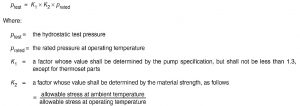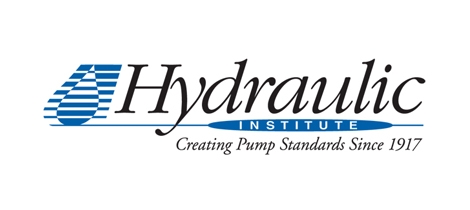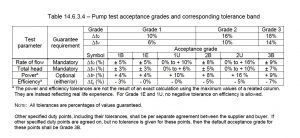The Hydraulic Institute’s new test standard, ANSI/HI14.6, provides the pump community with a globally accepted standard for testing rotodynamic pumps, of the centrifugal, mixed flow, and axial types. It supersedes two test standards: ANSI/HI 1.6, for Centrifugal Pumps and ANSI/HI 2.6 for Vertical Pumps. The new standard features significant changes in test acceptance requirements and in educational content and contains “must-know” requirements for anyone involved with hydrostatic or performance testing of pumps.
Significant updates:
- Superseded standard: Two test acceptance levels. New standard: Three levels of acceptance: Grade 1 with a tighter tolerance band that can be applied in three acceptance grates (1U, 1E, 1B); Grade 2 with a broader tolerance band can be applied in two acceptance grades (2B, 2U); and Grade 3 with an even broader tolerance band. Acceptance grades 1U and 2U permit no negative tolerance.
- The new standard spells out measurement uncertainty and allowable measurement fluctuations in greater detail than the old standard.
- The new standard goes into a more detailed discussion of the tolerance band and what constitutes acceptance
- The new standard allows a wider efficiency tolerance for pumps with an input power below 10 kW
- The new standard defines industry-specific default test acceptance grades for cases where the user has not defined an acceptance grade
- The new standard has an informative appendix that provides information about various types of measurement equipment
- The new standard has an informative appendix that provides information about performing string tests
- The new standard has an informative appendix that provides educational information about testing parameter and variations.
Performance test acceptance grades and tolerances
Pump performance acceptance grades for flow, head, efficiency, and power are used in ANSI/HI 14.6 when evaluating acceptance of a pump for a guarantee point. The following table is included in the new standard to help the user select appropriate acceptance grades and tolerance bands for each application:
The purchaser and manufacturer can agree to use any grade to judge if a specific pump will meet a guarantee point. If a guarantee point is given, but no acceptance grade is specified, then this standard reverts to a default test acceptance grade that is based on the purchaser’s intended service.
For pumps with a shaft power input up to 10 kW (13 hp) but larger than 1 kw (1.3 hp) the tolerance factors shown in the table may be too stringent. If not otherwise agreed to between manufacturer and purchaser, the tolerance factors shall be as follows for pumps falling within this range:
Methods for evaluating efficiency and power are included in the standard. For pumps with shaft power input of 1kW (1.3 hp) and below, special agreements should be made between the purchaser and manufacturer.
Evaluation of flow, head, power, and efficiency
Guarantee point evaluation shall be performed at the rated speed. In order to determine whether a pump meets the acceptance criteria, a plot of pump total head versus rate of flow is produced and measured against the corresponding tolerance bands for the specified acceptance grade. The guarantee point for acceptance is now defined as flow and head for one set of conditions. In a similar fashion, the efficiency and power plots versus rate of flow are produced and measured against the tolerance bands for the specified acceptance grade.
String test
An important addition to the standard is Appendix G, String Test, which covers performance testing of the entire pumping system, including the motor, pump, and drive (e.g., gearbox, belt drive, etc.). This is a less accurate method of determining the true pump efficiency, since the input power to the pump shaft is calculated by taking into account the published motor and drive efficiencies. Since these efficiencies are not known precisely, this method of calculating pump input power is less accurate than when the shaft torque and rpm are directly measured.
When a VFD is used as part of the string, it becomes very difficult to obtain an accurate value of input power to the pump shaft. Although many VFDs provide a measurement of output power, the value of this power is only approximate and is generally not accurate enough for acceptance testing. This reading also does not account for the reduction in motor efficiency when operated on VFD power.
Hydrostatic pressure testing
The hydrostatic test pressure and test duration have been updated in the new test standard. The test pressure relates to the rated pressure at the ambient temperature of the item to be tested and is determined by the following:

The test duration is determined by the rated pressure level, with greater time required for those parts subjected to higher pressure.
Benefits of adopting the ANSI/HI Standard 14.6 – Rotodynamic Pumps for Hydraulic Performance Acceptance Tests
The Hydraulic Institute is known among the global pump user and OEM community for standards address definitions, nomenclature, pump applications, installation, operation, as well as important test procedures for a variety of different pump types. As these standards evolve over time, it is in the best interests of those within the pump industry to consider how these standards impact the bottom line of their business…and to stay current with the latest HI standards.
The information provided in ANSI/HI standards helps eliminate costly mistakes in pumping system projects, enhance project efficiency, and provides detailed trouble shooting guidance and many other benefits. Keeping in touch with the most recent versions of these standards is necessary for pump users, engineering consulting firms, pump OEMs, pump distributors, and suppliers to the pump industry.
Additional resources provided by the Hydraulic Institute
For a complete analysis of the new standard, visit www.Pumps.org and search for ANSI/HI 14.6-2011 Rotodynamic Pumpsunder the Products > Standards and Guidelines section to obtain your copy of the standard. A full-length version of this article is available at www.Pumps.org/FreeStuff.
In order to gain an understanding of the differences between ANSI/HI 14.6 and ANSI/HI 1.6 and 2.6, view a recorded 1-hour webinar titled What’s changing in Rotodynamic Pump Acceptance Tests in North America?, by visiting:www.PumpSystemsMatter.org A new webinar will be held on December 18, 2012, at 1:00-2:00pm EST. Register at: www.PumpSystemsMatter.org/Webinars.
This webinar provides complimentary information on the significant differences between the previous versions and the new ANSI/HI 14.6 standard. From this Web site you can also access various E-Learning Courses, view Featured PSM Trainings, and access other informational and educational tools regarding pumps, pump systems, and pump standards. Upcoming webinars, delivered by leading industry experts, is also listed on www.PumpSystemsMatter.org. Participants in HI/PSM technical webinars are eligible to earn Professional Development Hour (PDH) credit.
The Hydraulic Institute offers an extensive body of pump industry knowledge in its standards and guidelines, and Pump Systems Matter offers excellent training resources. To learn more about HI membership download the new “HI App” in the Apple App Store or Google Play Store. Search on “Hydraulic Institute” to download this useful tool to any Apple or Android tablet device.





